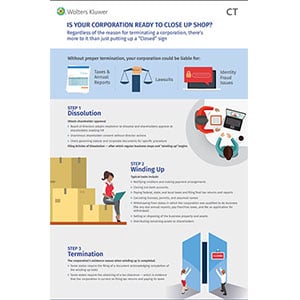According to the Taxpayer Advocate Service, the IRS flagged 5.2 million tax refunds for fraud in 2020. If your corporation is ready to close up shop, consider the following actions to reduce future risk.
Dissolution
The first step to closing up shop is receiving shareholder approval to formally close the corporation. The board of directors should adopt a resolution to dissolve the corporation and receive approval for the action. Review the governing statutes and corporate documents for specific details related to your corporation.
Winding up
Notify creditors and make payment arrangements for all debts. Close bank accounts and pay federal, state and local taxes along with filing the appropriate returns. Relevant permits should be canceled along with assumed names. Sell any remaining business property and distribute the appropriate funds to shareholders.
Termination
The corporation’s existence ceases when the “winding up” phase is complete. A state may require the filing of a document that acknowledges the completion of these various tasks. States may also require a corporation to receive tax clearance as evidence that the corporation is current on filing tax returns and paying amounts due.
Conclusion
Terminating a corporation is a complicated process, but it’s critical to minimize any potential risk in the future. Accomplishing the necessary tasks protects corporations from being responsible for future taxes, annual reports and risks associated with lawsuits and identity theft.
A legal advisor can assist with navigating the necessary steps, such as filing dissolutions, termination, withdrawal documents, annual reports, tax clearances and much more, to ensure that no process is left undone.




